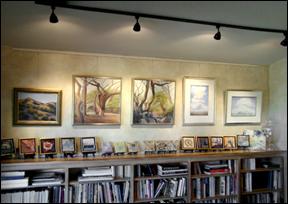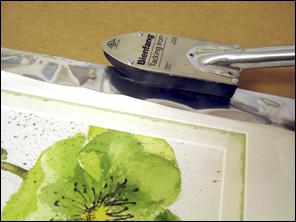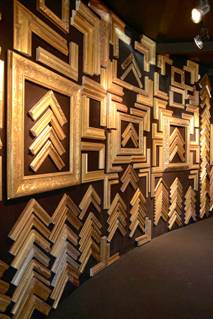 Photo 1
Photo 1
Professional level gallery and studio hanging systems Arakawa, Takiya, STAS, Newly may be purchased and installed by most full-service framers. This is an Arakawa system installed at Walker-Strahan Studio, Redding CA, USA.
Framing is often an afterthought for artists, frequently considering it expensive and sometimes intimidating—created by far too many choices and decisions to be made. Very often artists frame their own work to save money, purchasing bargain frames and learning basic framing techniques online, thinking how hard can it be to put art in a frame? At a group exhibition I once pointed out to an artist friend he had pressed his original watercolor up against the glass and he proudly announced, "That's OK, I sold it already, so it it's not my problem." And therein lay the problem.
Having your art professionally framed should not be intimidating nor an annoyance, but rather an attempt to develop a good working relationship with a trained professional framer so the two of you become a collaborative team that works toward the very best at enhancing and protecting your fine art, whether for sale or personal enjoyment.
Advantages of Using a Framer
There's more to a framer than simply framing your art. A bespoke framer is trained in the care and preservation of art as it pertains to long term display. Not only can they guide you through the design process they can also explain the FATG 'Five Levels of Framing' standards; the pros and cons of glass or acrylic when glazing; various mounting methods for your medium; and why any of these might be the correct or incorrect choice for your medium. A reputable framer is not about pushing for a higher priced sale, but rather finding the proper materials for the art being framed, at a price that works for the client.
Working with a framer is more than convenience; it's also an opportunity to learn more about the care of your art. A framer should always talk with you about the preservation of your original and should suggest reversible methods and neutral materials when framing or preparing for storage. If you opt out of preservation methods you may be asked to sign a release so the framer is not responsible for damage that may occur over time. Keep in mind that your framer may know more about the display and care of your original than you, but as the customer and artist the final choices about framing will be yours—right or wrong.
A qualified frame designer will assist you in your selections, as a wall of 3000 frame corners and a thousand mat samples may be overwhelming. A good designer should offer you two or three different approaches to showcase your piece while always maintaining the dignity of the medium, be it watercolor, oil, pastel or other. Your designer should be able to point out why the selected colors, spacers and frame(s) work with your art and help draw the eye into it. A frame should complete a piece of art, becoming a part of the unified presentation, never distracting from it.
Other expanded services available from full service framers may also include: home or business delivery; individual installation; and/or installation of professional hanging systems like Arakawa, Takiya, STAS, and Newly. (photo 1)
 Photo 1
Photo 1
Professional level gallery and studio hanging systems Arakawa, Takiya, STAS, Newly may be purchased and installed by most full-service framers. This is an Arakawa system installed at Walker-Strahan Studio, Redding CA, USA.
What a Framer Needs to Know
Your framer will begin by asking a few basic questions to get to know a little about you, your home and your art. It helps them knowing wall color, flooring, furnishing style and personal design aesthetics, but that does not mean your framing should match the sofa. When framing is designed for the art it will meld into any décor.
Your framer should ask if you have a vision for the framing or anything specific in mind. They also need to know if there is an expedited turnaround time or if there is a budget, this is particularly the case with corporate projects or exhibitions. They will also need to know if there are any specific installation challenges like a brick or marble wall, or location issues such as basement or bathroom moisture. The intended display location will dictate hardware needs and if special treatments are required, like using Marvelseal——an aluminized polyethylene and nylon barrier film—to seal the inner package against moisture and humidity. (photo 2)
 Photo 2
Photo 2
This original watercolor was to be displayed in a bathroom, so it required a sealed package of Marvelseal as a protective, flexible, heat-sealable barrier material that resists the transmission of oxygen and water vapor.
Be prepared to discuss your particular medium in terms of your historical, traditional or competition/exhibition requirements. don't hesitate to share what you know, but also be open to framer suggestions, and learn as much as you can from each other.
Selecting a Framer
If a framer has been recommended to you that is very good, positive word of mouth is always best acclaim. Look around when you arrive and review framed samples on the wall. Most framers will specialize in something—tabernacle or multi angle frames; surface mount decoration; hand carved, closed corner gold leaf frames (photo 3); needleart; memorabilia—and these are all signs of framer's skill and education.
 Photo 3
Photo 3
Goldleaf Framemakers of Santa Fe, NM is a high-end resource for many framers for period frames. They assist, online and in person, in the research and make suggestions in able to create authentic presentations.
Look for shops that advertise they are members of Fine Art Trade Guild (FATG) and promote having one or more accredited Guild Certified Framers (GCF) on staff. Designations are awarded to FATG members who have studied and past written and hands-on tests proving their skills in the major segments of picture framing allowing them a working knowledge of art mediums, preservation, mounting, matting, frame construction, glazing, needleart, canvas, and objects. A well trained framer will also know their limitations and are knowledgeable in when they should be helping you locate a conservator about your project. That doesn—t make them less of a framer, it makes them honest.
If you have special concerns or requests it might help to write them down so you do not forget them, and try to remember that not all imagined framing desires are possible to achieve. don't hesitate to ask for explanations about everything particularly preservation techniques or why they are important. Framers are not allowed to alter your art in any way. If you want something cropped square you need do that before you arrive. If you plan to have your completed original art mounted to a backing board it needs to be done prior to applying any pigment or medium. Framers cannot apply fixatives, lacquers or trim original art in any way, and if they offer to do so, they may not be the framer for you.
Framing Costs
All too often framing is often a stressor artist's feel eats up money. Frames are made of hardwoods, soft woods, MDF (multiple density fiber board) and polystyrene. Profiles and colors may appear similar when viewed as corner samples or readymade frames, but the weight and/or price of the frame will tell. You do get what you pay for. You will save money if you opt for a narrower or smaller profile, but don't go to plastic or MDF. Use a single mat rather than a triple mat with spacers, but don't skimp on preservation mounting or mat boards less than conservation quality. Regular glass is significantly cheaper than museum glass, but don't use less than UV glazing.
Collectors expect the best and authentic styles and period for historic art. Original Western oil paintings by artists from the Taos Society of Artists, circa 1915, (photo 4) should be framed with a period replica hand-carved, closed corner, gold leaf frame to be authentic, but a contemporary cowboy painting with that flavor may opt for a rustic barnwood frame at a fraction of the cost. Know what you have an frame accordingly.
 Photo 4
Photo 4
This custom hand carved, closed corner, gold leaf frame was created specifically for a painting from the Taos Society of Artists, circa 1915, as would have been used by artist Ned Jacobs on this/his original oil painting.
When completing a series of paintings for an exhibition, there should be continuity. Artists often bargain shop their frames thinking the frame is not important, which may unintentionally reduce the sales potential at the exhibition. A cheap frame will make the art look cheap, but the right frame will increase the value of your art. If you are planning on displaying your painting for sale you need to consider the target market and not think from the pocketbook, investing in quality materials and workmanship is always the smarter decision, and the ticket price of your art should always include the expense of the framing.
END
Copyright © 2017 Chris A Paschke
Resources—Items
http://www.campbellsoflondon.co.uk—Gilded frames
http://www.frintonframes.co.uk—Gilded period frames
http://www.goldleafpictureframes.com—Hand-carved, gilded, closed-corner frames
http://www.preservationequipment.com—Marvelseal
http://www.lionpic.co.uk—Takiya, STAS systems UK, Newly, J-Rail
http://larsonjuhl.com—Arakawa
"Sealed Frames In The Real World"
"Hanging Systems For Home & Gallery"
For more articles on mounting basics look under the mounting section in Articles by Subject.
Additional information on all types of mounting is found in:
The Mounting and Laminating Handbook, Second Edition, 2002,
The Mounting And Laminating Handbook, Third Edition, 2008 and
Creative Mounting, Wrapping, And Laminating, 2000 will teach you everything you need to know about getting the most from your dry mount equipment and materials as an innovative frame designer.
All books are available from Designs Ink Publishing through this website.
Chris A Paschke, CPF GCF
Designs Ink
Designs Ink Publishing
785 Tucker Road, Suite G-183
Tehachapi, CA 93561
P 661-821-2188
chris@designsinkart.com